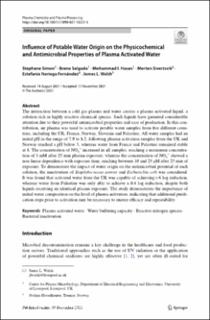| dc.contributor.author | Simon, Stephane | |
| dc.contributor.author | Salgado, Breno | |
| dc.contributor.author | Hasan, Mohammad I. | |
| dc.contributor.author | Sivertsvik, Morten | |
| dc.contributor.author | Noriega Fernández, Estefanía | |
| dc.contributor.author | Walsh, James Leon | |
| dc.date.accessioned | 2022-02-11T09:53:13Z | |
| dc.date.available | 2022-02-11T09:53:13Z | |
| dc.date.created | 2022-02-09T11:35:47Z | |
| dc.date.issued | 2021 | |
| dc.identifier.citation | Plasma chemistry and plasma processing. 2021, 1-17. | |
| dc.identifier.issn | 0272-4324 | |
| dc.identifier.uri | https://hdl.handle.net/11250/2978427 | |
| dc.description.abstract | The interaction between a cold gas plasma and water creates a plasma activated liquid, a solution rich in highly reactive chemical species. Such liquids have garnered considerable attention due to their powerful antimicrobial properties and ease of production. In this contribution, air plasma was used to activate potable water samples from five different countries, including the UK, France, Norway, Slovenia and Palestine. All water samples had an initial pH in the range of 7.9 to 8.2, following plasma activation samples from the UK and Norway reached a pH below 3, whereas water from France and Palestine remained stable at 8. The concentration of NO3− increased in all samples, reaching a maximum concentration of 3 mM after 25 min plasma exposure; whereas the concentration of NO2− showed a non-linear dependence with exposure time, reaching between 10 and 25 µM after 25 min of exposure. To demonstrate the impact of water origin on the antimicrobial potential of each solution, the inactivation of Staphylococcus aureus and Escherichia coli was considered. It was found that activated water from the UK was capable of achieving > 6 log reduction, whereas water from Palestine was only able to achieve a 0.4 log reduction, despite both liquids receiving an identical plasma exposure. The study demonstrates the importance of initial water composition on the level of plasma activation, indicating that additional purification steps prior to activation may be necessary to ensure efficacy and repeatability. | |
| dc.language.iso | eng | |
| dc.title | Influence of Potable Water Origin on the Physicochemical and Antimicrobial Properties of Plasma Activated Water | |
| dc.type | Peer reviewed | |
| dc.type | Journal article | |
| dc.description.version | publishedVersion | |
| dc.source.pagenumber | 1-17 | |
| dc.source.journal | Plasma chemistry and plasma processing | |
| dc.identifier.doi | 10.1007/s11090-021-10221-3 | |
| dc.identifier.cristin | 1999442 | |
| dc.relation.project | Norges forskningsråd: 281106 | |
| cristin.ispublished | true | |
| cristin.fulltext | original | |
| cristin.qualitycode | 1 | |
